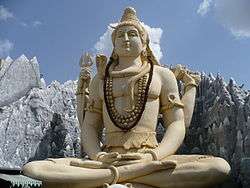Shiv Chalisa

Shiv Chalisa (Hindi: शिव चालीसा, literally Forty chaupais on Shiva) is a devotional song dedicated to Hindu deity, Lord Shiva.[1] Adapted from the Shiva Purana, it consists of 40 (Chalis) chaupais (verses) and recited daily or on special festivals like Maha Shivaratri by Shivaites, and worshippers of Shiva.[2][3]
Shiva
Shiva is a major Hindu deity and the Destroyer or transformer of the Trimurti. Shiva is usually worshipped in the abstract form of Shiva linga. In images, he is generally in deep meditation or dancing the Tandava. Lord Mahesh or Shiva, the 3rd God of the Hindu Trimurti, is the Destroyer. He represents the hot-blooded deity. His attributes represents victory over the demonic activity, and calmness of human nature.
Overview
Lord Shiv is the Hindu Trinity of the primary aspects of the divine which have dominion over death and destruction. He appears in a meditating but ever-happy posture having matted hair which holds the flowing Ganges river and a crescent moon, a serpent coiled around his neck, a trident (trishul) in his one hand and ashes all over his body. He is known as the "giver" god. His vehicle is a bull (symbol of happiness and strength) named Nandi.
Shiva-Linga, a sign of the Lord, is adored instead of him. Shiva is also considered the greatest of the yogis, the lord of meditation, and the lord of all that is in Hindu practices. Legend has it that the holy river Ganges (or Ganga) is in fact a representation of Lord Shiva's long hair.
Some texts refer to the five letters as the forms of Shiva - Na-gendra (one who wears a garland of snakes), Ma-ndakini Salila (one who is bathed by the water of the Ganges), Shi (the supreme Lord), Va-shishta (one who is praised by the sages like Vashishta), and Ya-ksha (one who takes the form of Yaksha). The Om Namah Shivaya mantra or chant consists of six syllables - om, na, mah, shi, vaa, ya. The Shiv Chalisa are 40 chaupais (verses) is written in praise of Lord Shiva.
See also
Further reading
- Sri Shiv Chalisa (Dicritical)', by Manoj Pub. Ed. Board. Manoj Publications, 2009. ISBN 81-310-0927-0.
References
- ↑ Chaturvedi, B. K. "5. Shree Shiv Chalisa". The Hymns And Orisions Of Lord Shankar. Diamond Pocket Books. p. 63. ISBN 81-7182-169-3.
- ↑ Jha, Makhan (1997). Anthropology of ancient Hindu kingdoms: a study in civilizational perspective. M.D. Publications. p. 39. ISBN 81-7533-034-1.
- ↑ Pattanaik, Devdutt (1997). Shiva: an introduction. Vakils, Feffer and Simons Ltd. p. 104.
External links
- Shiv Chalisa in English rhyme
- Shiv Chalisa in Sanskrit with Hindi translation and Pictures
- Video, Text and meaning of Shiv Chalisa in English
- Shiv Chalisa in English
- Tandava by Ravan
